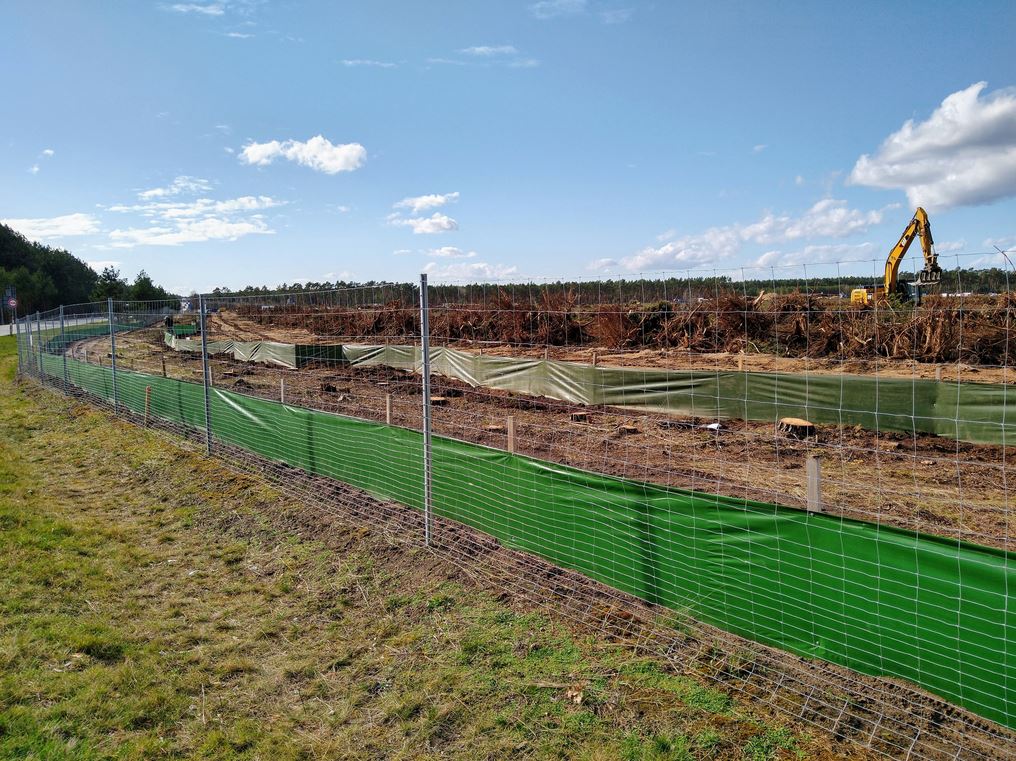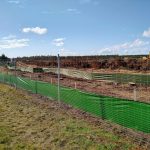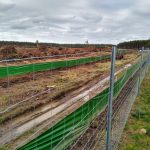

News
Tesla Giga Berlin installs reptile fences to protect endangered sand lizards
Tesla installed reptile fences in the Grunheide industrial property to protect lizards from migration to the Giga Berlin construction site.
As of Thursday, a double fence has been erected on the south side of the Tesla forest to protect reptiles and other animals that might cross from the nearby woods. Aside from protecting the lizards from being accidentally harmed at the construction site, sand lizards are also protected by European and construction sites must hire experts to catch each animal by snaring them and then resettling them to another location. The relocation of each sand lizard may cost up to 4,000 euros or roughly $4,500. Railway officials in Germany recently spent 15 million euros to relocate sand lizards from a transport hub in Stuttgart.
Tesla enthusiast Tobias Lindh shared on Twitter images of the completed barrier.
- Giga Berlin Reptile Fence (Source: Tobias Lindh | Twitter)
- Giga Berlin Reptile Fence (Source: Tobias Lindh | Twitter)
- Giga Berlin Reptile Fence (Source: Tobias Lindh | Twitter)
- Giga Berlin Reptile Fence (Source: Tobias Lindh | Twitter)
They really make sure that no lizard enters #GigaBerlin pic.twitter.com/cvhykRjLit
— Tobias Lindh (@tobilindh) March 12, 2020
GF4Tesla who has also been closely following the developments at the site of Tesla’s first Gigafactory in Europe, also shared on Twitter recent images taken at the site that show the enclosure that separates the build site from another portion of the forest.
#Speciesprotection 🤲
The reptile fence will be built on the south side of the site to prevent lizards🦎 and vipers🐍 from migrating to the GF4 site from the opposite woods.🌲🌲🌲 pic.twitter.com/1Js4kbqPyz— Gigafactory Berlin News (@Gf4Tesla) March 11, 2020
Earlier this week, the State Environment Agency in Brandenburg gave Tesla the green light to continue with the preparation works at the Giga Berlin construction site while the complete environmental permits are still pending. The approval means Tesla can now remove the topsoil and level the 92 hectares that have been cleared for the first phase of its construction.
The construction of the reptile fences is consistent with the environmental protection plan presented by Tesla to the Brandenburg government, concerned environmental groups, and local residents. During the construction of Giga Berlin, Tesla will resettle reptiles and other animals found in the site following the recommendations of experts in the country.
In addition to the protective fences to keep reptiles away, Tesla have also clearly marked areas where wood ant nests are located. The wood ants are also tagged as endangered species. The ant colonies should be first resettled before leveling those specific portions of the cleared Giga Berlin property.
Tesla can level the area now. The State Office for the Environment has issued the appropriate permit.
Bat trees must remain standing until the animals have left their winter quarters.
Even areas with wood ants' nests can only be levelled after the nests have been resettled. pic.twitter.com/gSRwA6xU9F— Gigafactory Berlin News (@Gf4Tesla) March 10, 2020
Trees with bats were also not uprooted to allow the animals to complete their winter hibernation. Experts assured concerned citizens that the engine noise, loud trucks, and noise created by chainsaws in the construction site will not be harmful to the bats. The endangered bats in the Grunheide forest started their hibernation in February and will likely last until the end of March as their mating season begins.
“You don’t have to worry about the animals. Bats are slowly waking up and leaving their winter accommodations,” said Peter Busse from the Working Group on Bats in Saxony-Anhalt who has been volunteering for the protection of animals for 40 years.
In January, Tesla CEO Elon Musk assured the public that Tesla will be built with sustainability and the environment in mind.
Giga Berlin / GF4 will absolutely be designed with sustainability and the environment in mind
— Elon Musk (@elonmusk) January 25, 2020

Elon Musk
Elon Musk and Tesla AI Director share insights after empty driver seat Robotaxi rides
The executives’ unoccupied tests hint at the rapid progress of Tesla’s unsupervised Robotaxi efforts.

Tesla CEO Elon Musk and AI Director Ashok Elluswamy celebrated Christmas Eve by sharing personal experiences with Robotaxi vehicles that had no safety monitor or occupant in the driver’s seat. Musk described the system’s “perfect driving” around Austin, while Elluswamy posted video from the back seat, calling it “an amazing experience.”
The executives’ unoccupied tests hint at the rapid progress of Tesla’s unsupervised Robotaxi efforts.
Elon and Ashok’s firsthand Robotaxi insights
Prior to Musk and the Tesla AI Director’s posts, sightings of unmanned Teslas navigating public roads were widely shared on social media. One such vehicle was spotted in Austin, Texas, which Elon Musk acknowleged by stating that “Testing is underway with no occupants in the car.”
Based on his Christmas Eve post, Musk seemed to have tested an unmanned Tesla himself. “A Tesla with no safety monitor in the car and me sitting in the passenger seat took me all around Austin on Sunday with perfect driving,” Musk wrote in his post.
Elluswamy responded with a 2-minute video showing himself in the rear of an unmanned Tesla. The video featured the vehicle’s empty front seats, as well as its smooth handling through real-world traffic. He captioned his video with the words, “It’s an amazing experience!”
Towards Unsupervised operations
During an xAI Hackathon earlier this month, Elon Musk mentioned that Tesla owed be removing Safety Monitors from its Robotaxis in Austin in just three weeks. “Unsupervised is pretty much solved at this point. So there will be Tesla Robotaxis operating in Austin with no one in them. Not even anyone in the passenger seat in about three weeks,” he said. Musk echoed similar estimates at the 2025 Annual Shareholder Meeting and the Q3 2025 earnings call.
Considering the insights that were posted Musk and Elluswamy, it does appear that Tesla is working hard towards operating its Robotaxis with no safety monitors. This is quite impressive considering that the service was launched just earlier this year.
Elon Musk
Starlink passes 9 million active customers just weeks after hitting 8 million
The milestone highlights the accelerating growth of Starlink, which has now been adding over 20,000 new users per day.

SpaceX’s Starlink satellite internet service has continued its rapid global expansion, surpassing 9 million active customers just weeks after crossing the 8 million mark.
The milestone highlights the accelerating growth of Starlink, which has now been adding over 20,000 new users per day.
9 million customers
In a post on X, SpaceX stated that Starlink now serves over 9 million active users across 155 countries, territories, and markets. The company reached 8 million customers in early November, meaning it added roughly 1 million subscribers in under seven weeks, or about 21,275 new users on average per day.
“Starlink is connecting more than 9M active customers with high-speed internet across 155 countries, territories, and many other markets,” Starlink wrote in a post on its official X account. SpaceX President Gwynne Shotwell also celebrated the milestone on X. “A huge thank you to all of our customers and congrats to the Starlink team for such an incredible product,” she wrote.
That growth rate reflects both rising demand for broadband in underserved regions and Starlink’s expanding satellite constellation, which now includes more than 9,000 low-Earth-orbit satellites designed to deliver high-speed, low-latency internet worldwide.
Starlink’s momentum
Starlink’s momentum has been building up. SpaceX reported 4.6 million Starlink customers in December 2024, followed by 7 million by August 2025, and 8 million customers in November. Independent data also suggests Starlink usage is rising sharply, with Cloudflare reporting that global web traffic from Starlink users more than doubled in 2025, as noted in an Insider report.
Starlink’s momentum is increasingly tied to SpaceX’s broader financial outlook. Elon Musk has said the satellite network is “by far” the company’s largest revenue driver, and reports suggest SpaceX may be positioning itself for an initial public offering as soon as next year, with valuations estimated as high as $1.5 trillion. Musk has also suggested in the past that Starlink could have its own IPO in the future.
News
NVIDIA Director of Robotics: Tesla FSD v14 is the first AI to pass the “Physical Turing Test”
After testing FSD v14, Fan stated that his experience with FSD felt magical at first, but it soon started to feel like a routine.

NVIDIA Director of Robotics Jim Fan has praised Tesla’s Full Self-Driving (Supervised) v14 as the first AI to pass what he described as a “Physical Turing Test.”
After testing FSD v14, Fan stated that his experience with FSD felt magical at first, but it soon started to feel like a routine. And just like smartphones today, removing it now would “actively hurt.”
Jim Fan’s hands-on FSD v14 impressions
Fan, a leading researcher in embodied AI who is currently solving Physical AI at NVIDIA and spearheading the company’s Project GR00T initiative, noted that he actually was late to the Tesla game. He was, however, one of the first to try out FSD v14.
“I was very late to own a Tesla but among the earliest to try out FSD v14. It’s perhaps the first time I experience an AI that passes the Physical Turing Test: after a long day at work, you press a button, lay back, and couldn’t tell if a neural net or a human drove you home,” Fan wrote in a post on X.
Fan added: “Despite knowing exactly how robot learning works, I still find it magical watching the steering wheel turn by itself. First it feels surreal, next it becomes routine. Then, like the smartphone, taking it away actively hurts. This is how humanity gets rewired and glued to god-like technologies.”
The Physical Turing Test
The original Turing Test was conceived by Alan Turing in 1950, and it was aimed at determining if a machine could exhibit behavior that is equivalent to or indistinguishable from a human. By focusing on text-based conversations, the original Turing Test set a high bar for natural language processing and machine learning.
This test has been passed by today’s large language models. However, the capability to converse in a humanlike manner is a completely different challenge from performing real-world problem-solving or physical interactions. Thus, Fan introduced the Physical Turing Test, which challenges AI systems to demonstrate intelligence through physical actions.
Based on Fan’s comments, Tesla has demonstrated these intelligent physical actions with FSD v14. Elon Musk agreed with the NVIDIA executive, stating in a post on X that with FSD v14, “you can sense the sentience maturing.” Musk also praised Tesla AI, calling it the best “real-world AI” today.












